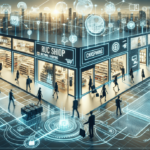The Benefits of Omnichannel Retail: How to Maximize Your Customer Experience
In today’s retail landscape, it’s no longer enough to simply have a brick-and-mortar store or an online presence. Consumers expect a seamless shopping experience across all channels, and that’s where omnichannel retail comes in. In this article, we’ll explore what omnichannel retail is, why it’s important, and how businesses can maximize their customer experience with this approach.
What is Omnichannel Retail and Why is it Important?
Omnichannel retail is a strategy that integrates all sales channels, such as brick-and-mortar stores, online marketplaces, social media, and mobile apps, to provide a seamless shopping experience for customers. This means that customers can browse products in-store, purchase them online, and have them shipped to their doorstep, or vice versa.
This approach is important because it meets the changing expectations of today’s customers, who want convenience, speed, and flexibility in their shopping experience. According to a study by Salesforce, more than 70% of customers expect consistent interactions across all channels, and are willing to shop more frequently with retailers who provide them.
Another benefit of omnichannel retail is that it allows retailers to gather more data about their customers. By tracking customer behavior across multiple channels, retailers can gain insights into their preferences, purchase history, and shopping habits. This information can then be used to personalize the shopping experience, offer targeted promotions, and improve customer retention.
Furthermore, omnichannel retail can help retailers to stay competitive in a crowded marketplace. By offering a seamless shopping experience across all channels, retailers can differentiate themselves from their competitors and attract new customers. This is particularly important in today’s digital age, where customers have more options than ever before and are quick to switch to a competitor if they are not satisfied with their experience.
The Evolution of Retail: From Brick-and-Mortar to Omnichannel
The concept of omnichannel retail is not new, but it has evolved significantly as technology and customer behavior have changed. In the past, retail was largely confined to physical storefronts, and customers had to visit stores in person to make purchases. With the advent of e-commerce, customers could shop online from the comfort of their homes. Now, with smartphones and mobile apps, customers can shop anytime, anywhere, and from any device.
Omnichannel retail recognizes that customers expect a seamless experience across all these touchpoints and aims to provide it. By integrating all channels, businesses can enhance their customer experience, increase customer loyalty, and drive sales and revenue.
One of the key benefits of omnichannel retail is the ability to collect and analyze customer data from multiple sources. By tracking customer behavior across all channels, businesses can gain valuable insights into their preferences, habits, and needs. This data can then be used to personalize the customer experience, offer targeted promotions, and improve product offerings. Additionally, omnichannel retail allows businesses to better manage inventory and fulfillment, as they can leverage multiple channels to fulfill orders and optimize stock levels.
How Omnichannel Retail Can Boost Your Sales and Revenue
One of the key benefits of omnichannel retail is increased sales and revenue. By providing customers with multiple channels to browse and purchase products, businesses can reach more customers and provide more opportunities for conversion.
Furthermore, omnichannel customers tend to spend more than single-channel customers. A study by Harvard Business Review found that omnichannel customers spent an average of 4% more on each shopping occasion in-store, and 10% more online, compared to single-channel customers.
In addition to increased sales and revenue, omnichannel retail can also improve customer loyalty. By offering a seamless shopping experience across multiple channels, businesses can build stronger relationships with their customers. This can lead to repeat purchases and positive word-of-mouth recommendations.
Another advantage of omnichannel retail is the ability to gather valuable data on customer behavior. By tracking customer interactions across different channels, businesses can gain insights into customer preferences and buying habits. This information can be used to personalize marketing efforts and improve the overall customer experience.
Creating a Seamless Shopping Experience Across All Channels
To create a seamless shopping experience across all channels, businesses need to:
- Integrate Sales Channels: Ensure that all sales platforms (online, mobile, in-store) are interconnected. This allows customers to transition smoothly between channels without losing their shopping carts or history.
- Consistent Branding and Messaging: Maintain uniform branding across all platforms, including website design, mobile apps, and physical storefronts, as well as advertising and promotional materials.
- Personalized Experiences: Utilize customer data and analytics to tailor product recommendations and promotions to individual preferences.
- Excellent Customer Service: Offer multiple channels for customer support, such as phone, email, and live chat, and ensure prompt and effective responses to inquiries.
By focusing on these areas, businesses can enhance the customer journey, increase satisfaction, and drive sales.
The Role of Technology in Omnichannel Retail: Trends and Innovations
Technology plays a critical role in enabling omnichannel retail. Key technological components include:
- Inventory Management Software: Helps track stock levels across all channels in real-time.
- Order Management Systems: Streamlines the order process from placement to fulfillment.
- Customer Relationship Management (CRM) Tools: Provides a unified view of customer interactions and data.
- Mobile Apps and Social Media Integration: Facilitates engagement and transactions through popular digital platforms.
One of the latest trends in omnichannel retail is the use of augmented reality (AR) technology. AR allows customers to virtually try on clothes or see how furniture would look in their home before making a purchase. This technology not only enhances the customer experience but also reduces the likelihood of returns, as customers can see how the product will look and fit before buying.
The Importance of Data Analytics and Customer Insights in Omnichannel Retail
Data analytics and customer insights are fundamental to the success of an omnichannel retail strategy. By tracking customer behavior across all channels and gathering data on their preferences, purchasing history, and interactions with the brand, businesses can:
- Personalize the Customer Experience: Tailor product recommendations and marketing messages to individual preferences.
- Optimize Product Offerings: Use data to understand which products are most popular and adjust inventory accordingly.
- Improve Marketing Strategies: Develop targeted promotions based on customer behavior and preferences.
- Enhance Customer Retention: Identify and address pain points in the customer journey to improve satisfaction.
Furthermore, data analytics can help businesses identify trends and patterns in customer behavior, enabling them to make informed, data-driven decisions about their omnichannel strategy.
Case Studies: Successful Implementation of Omnichannel Strategies by Top Brands
Starbucks
Starbucks enables customers to order and pay for their coffee via their mobile app, then pick it up at their preferred store. This integration of mobile and physical storefronts streamlines the customer experience and increases convenience.
Amazon
Amazon has integrated its online marketplace with physical stores, such as Amazon Go and Amazon Books, to provide a seamless shopping experience. Customers can transition effortlessly between online and offline shopping environments.
Nordstrom
Nordstrom’s Buy Online, Pick Up In-Store (BOPIS) service allows customers to order products online and collect them at a nearby store. This service combines the convenience of online shopping with the immediacy of in-store pickup.
Sephora
Sephora’s mobile app offers personalized product recommendations and tutorials, enhancing the shopping experience both online and in-store. The app’s integration with in-store technology helps bridge the gap between digital and physical retail.
Zara
Zara uses RFID technology to enable customers to scan items and find their preferred size and color in-store. This technology enhances inventory management and improves the shopping experience by making products more accessible.
Best Practices for Integrating Online and Offline Channels for Maximum Impact
To maximize the impact of their omnichannel strategy, businesses should follow these best practices:
- Invest in Technology: Utilize platforms that enable data integration and customer tracking across all channels.
- Ensure Consistent Branding: Maintain uniform branding and messaging across all touchpoints to create a cohesive customer experience.
- Personalize the Experience: Use customer data to tailor interactions and recommendations to individual preferences.
- Optimize Mobile Experience: Given the rise in mobile commerce, ensure that websites and apps are mobile-friendly and offer features like mobile payments and product scanning.
- Train Employees: Equip staff with the knowledge and tools to support a seamless omnichannel experience.
Overcoming Challenges in Implementing an Omnichannel Strategy: Tips and Tricks
Implementing an omnichannel strategy can present several challenges, including:
- Integrating Legacy Systems: Older systems may not be designed to work together, making integration difficult.
- Training Employees: Staff need to be trained to provide a seamless customer experience across all channels.
- Managing Customer Expectations: Ensuring consistent and high-quality experiences across all channels is essential to meet customer expectations.
To overcome these challenges, businesses should:
- Invest in Compatible Technology: Choose modern, flexible systems that can integrate easily with other platforms.
- Provide Comprehensive Training: Ensure that employees understand the omnichannel strategy and are equipped to support it.
- Communicate Clearly with Customers: Transparently communicate the benefits and processes of the omnichannel strategy to manage expectations effectively.
Measuring Success in Your Omnichannel Retail Strategy: Metrics to Track and Analyze
Measuring the success of an omnichannel retail strategy involves tracking various key metrics across all channels. These metrics include:
- Sales and Revenue: Monitor overall sales performance and revenue growth across all channels.
- Conversion Rates: Track the percentage of visitors who make a purchase.
- Customer Lifetime Value (CLV): Measure the total value a customer brings over the entire relationship.
- Customer Satisfaction: Use surveys and feedback to assess customer satisfaction levels.
- Engagement Metrics: Track social media followers, website traffic, and app usage to gauge customer engagement.
- Customer Behavior Metrics: Analyze browsing behavior and cart abandonment rates to identify and address potential issues in the shopping funnel.
By regularly monitoring these metrics, businesses can gain insights into customer preferences and behavior, enabling them to optimize their omnichannel strategy effectively.
Future Trends in Omnichannel Retail: What to Expect in the Coming Years
The future of omnichannel retail is promising, with new technologies and trends continually emerging. Key trends to watch in the coming years include:
- Growth of Mobile Commerce: As mobile usage continues to rise, mobile commerce will become even more integral to the retail experience.
- Artificial Intelligence and Machine Learning: These technologies will enhance personalization by analyzing customer data to provide more accurate recommendations and predictions.
- Integration of Voice Assistants: Voice commerce will become more prevalent, allowing customers to make purchases and interact with brands through smart speakers and voice-activated devices.
- Virtual and Augmented Reality: These technologies will offer immersive shopping experiences, allowing customers to visualize products in their environment before purchasing.
- Blockchain Technology: Blockchain can enhance the security and transparency of transactions and inventory management.
Staying ahead of these trends will enable retailers to continuously improve the customer experience and maintain a competitive edge in the market.
Conclusion: Why Every Business Should Embrace Omnichannel Retail
Omnichannel retail is no longer just a trend – it’s a necessity in today’s competitive retail landscape. By integrating all sales channels, providing a seamless shopping experience, and leveraging data analytics and customer insights, businesses can enhance their customer experience, increase customer loyalty, and drive sales and revenue.
While implementing an omnichannel strategy may present challenges, the benefits far outweigh the costs. As technology continues to evolve and customer behavior changes, businesses that embrace omnichannel retail are poised to succeed in the years ahead.




















